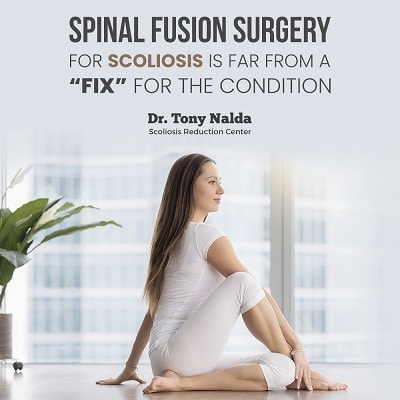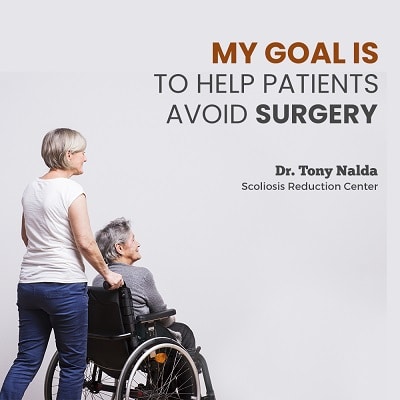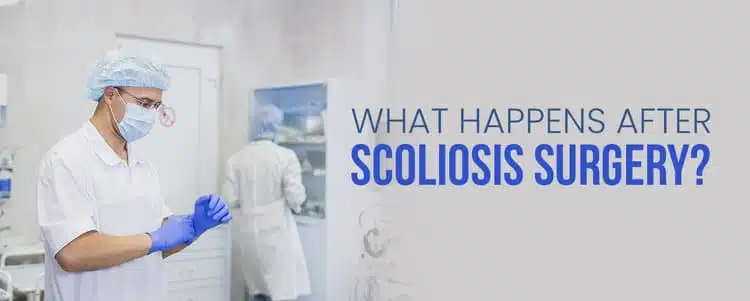Perhaps this is an oversimplification, but typically, there are two paths a person can take once they’ve received a scoliosis diagnosis. One is the path of traditional treatment. It involves watching and waiting — and not much active involvement from the patient. Eventually, this path leads to surgery.
The other path involves a less traditional approach, often guided by someone like me, a scoliosis-focused chiropractor. This path requires patients to take a more active approach to their healing, and it leads away from surgery.
I can understand why the traditional path is so heavily traveled. In our society, we tend to look for quick fixes, magic pills and “fixes” that don’t involve changes in behavior or lifestyle. To many scoliosis patients, surgery is a promise that helps them see a more hopeful future, so they follow orders from their doctors and patiently wait for the day they can finally go under the knife. They are convinced that the path they travel is the only one that leads to relief. And because the medical establishment endorses this path, they have no reason to look elsewhere for alternative approaches to treatment.
Unfortunately, scoliosis patients do not always travel this path with a full understanding of what it means.
The Realities of Scoliosis Surgery

Spinal fusion surgery for scoliosis is far from a “fix” for the condition. However, it can stabilize the spine and halt the progression of an abnormal spinal curvature. It is costly and invasive, but for many patients, the promise of relief is well worth the price they pay financially.
Individuals with scoliosis want relief so badly that they may not recognize the hardships that can come with surgery. And if they have been informed of alternative treatment approaches, such as the chiropractic-centered model, they may be intimidated by the sheer amount of work and participation that’s required of them. Or they have been convinced by medical professionals that alternative approaches are simply not legitimate.
Regardless, I think it is important for patients to understand what surgery truly entails.
Basically, most scoliosis surgeries involve the use of hooks and screws that are attached to the spine. These fasteners are used to anchor long rods. The surgeon will use the rods to reposition critical areas of the spine, reducing lateral curvatures.
Additionally, surgeons will graft bone to the segments of the vertebrae that will be fused.
This is a serious procedure. But what I just described is only the beginning. What happens after scoliosis surgery is important to understand, as well.
Life After Scoliosis Surgery
The rods that are installed during surgery act as splints to hold the spine in position while the fusion process occurs. This can take up to six months, with fusion continuing for up to a full year. Once the fusion process has completed, the spine is kept from curving abnormally by the recently fused bone. The rods typically remain in the body because removing them would require an additional surgery!
As for the patient’s ability to live a normal life, it is crucial to understand that recovery takes time.
A patient will be allowed to return home after surgery, but they will be weak, medicated and in need of time to rest. Bending, lifting, twisting, driving and numerous other activities are forbidden during the initial few weeks after surgery. Moreover, patients will require assistance from a friend, family member or other loved one to keep up with daily care and tasks.
Pain management is also a serious consideration after scoliosis surgery. Often, patients will be prescribed narcotics, which will ease their pain and discomfort. However, these drugs will also limit cognitive ability and reduce overall energy levels significantly.
Patients and their caregivers also need to be be diligent in the care of the surgical incision site. It needs to be kept clean and dry to ensure the best-possible recovery. Showers can be taken, but the incision site must be covered, either with a dressing provided by the surgeon’s staff, or with common kitchen plastic wrap.
After about two weeks, the patient will meet with their doctor for a follow-up appointment. This gives the patient the opportunity to ask questions and report on how they’re feeling. It gives the surgeon the opportunity to assess the patient and collaborate on a plan to move forward.
After the First Follow Up and Beyond
Patients are understandably anxious to get back to “normal” life at this point, but serious precautions still need to be made. Patients will be able to engage in social activities, ride in vehicles, go back to school and transition away from narcotic pain relief. However, rest and recovery should remain the top priorities
X-rays are taken at about the six-week mark following surgery. At this time, if the spine is healing properly, surgeons will permit patients to drive again and resume more normal activity.
Between six and twelve months after surgery, the fusion process will reach completion, and the patient will be able to resume most normal activities. But full and complete recovery does not occur until after the patient has healed from any trauma related to their surgery. This can take up to two years. But in reality, surgical patients are never really fully recovered — surgery is serious, and it impacts the way a person lives their life, even if the surgery is successful at stabilizing an abnormally curved spine.
Obviously, every patient is different, but this timeline is quite typical for those who travel the path of scoliosis treatment that leads to surgery.
The Chiropractic-Centered Treatment Path for Scoliosis

The path of healing I advocate for is much different. There is no watching and waiting to see what happens; we get to work. Through the efforts of the patient, my staff and myself, spinal curvatures can be reduced. It is not an easy process for patients to endure, but in my opinion, it is far preferable to surgery. My goal is to help patients avoid surgery. Conventional wisdom may say that surgery is the best we can do for scoliosis. But I believe otherwise, and my patients can prove it!
If you are interested in learning more about the differences between the traditional, surgery-focused treatment of scoliosis and the chiropractic-centered model, we are here to help. Give the team at the Scoliosis Reduction Center® a call at 321-939-2328 to learn more.





